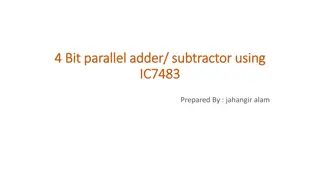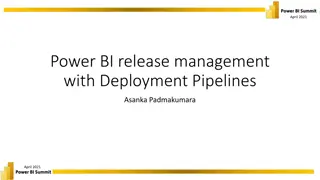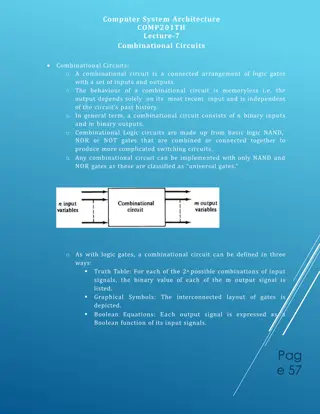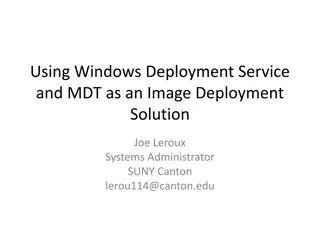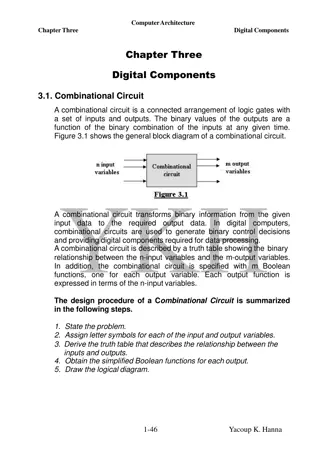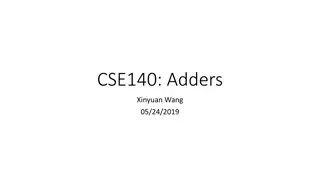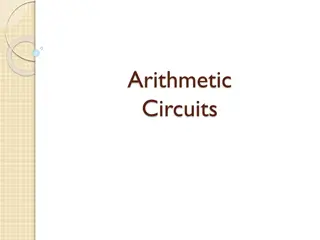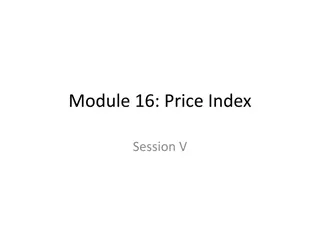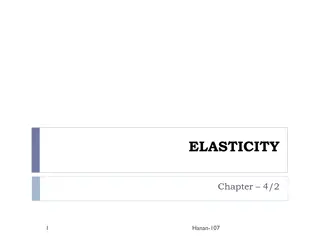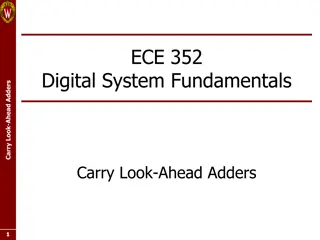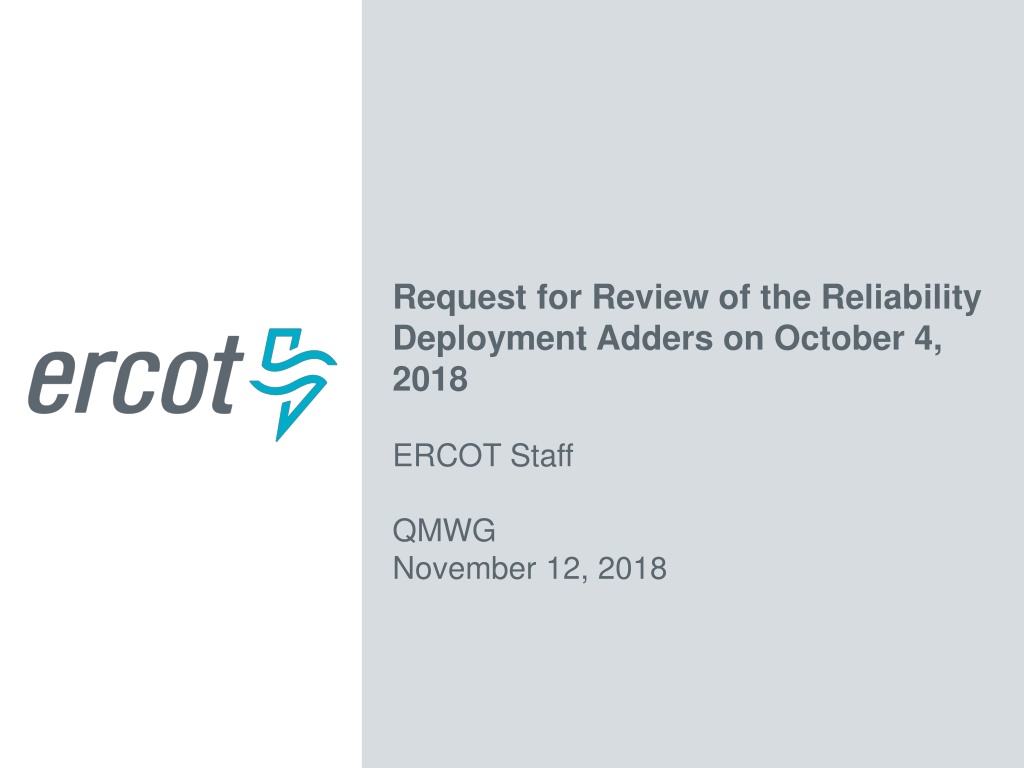
Reliability Deployment Price Adders Review
Dive into the analysis of reliability deployment price adders on October 4, 2018, by ERCOT staff and uncover the intricacies behind the values affecting pricing decisions within the energy sector.
Download Presentation

Please find below an Image/Link to download the presentation.
The content on the website is provided AS IS for your information and personal use only. It may not be sold, licensed, or shared on other websites without obtaining consent from the author. Download presentation by click this link. If you encounter any issues during the download, it is possible that the publisher has removed the file from their server.
E N D
Presentation Transcript
Request for Review of the Reliability Deployment Adders on October 4, 2018 ERCOT Staff QMWG November 12, 2018
Introduction A request was made to review the resulting reliability deployment price adders on 10/4/2018 In looking at this day and considering previous observations, ERCOT staff has identified some reasons why the reliability deployment price adder values may not necessarily always be intuitive This presentation focuses on simplified examples to better highlight those reasons and less on the specifics of 10/4/18 More detailed information for 10/4/18 could be provided during a future meeting, if needed 2 PUBLIC
SCED Pricing Run Methodology Overview For RUC-instructed Resources with a telemetered Resource Status of ONRUC and for RMR Resources that are On-Line, set the LSL, LASL, and LDL to zero. For all other Generation Resources excluding ones with a telemetered status of ONRUC, ONTEST, STARTUP, SHUTDOWN, ONRR, NA, and also excluding RMR Resources that are On-Line and excluding Generation Resources with a telemetered output less than 95% of LSL: Set LDL to Max ( LASL, TELEMW - 60*SDRAMP) Set HDL to Min ( HASL, TELEMW + 60*SDRAMP) For CLRs, excluding ones with a telemetered status of OUTL, set LDL and HDL according to protocol 6.5.7.3.1 (2) (c) 3 PUBLIC
SCED Pricing Run Methodology Overview Add deployed MW from NCLR and the deployed MW from ERS to GTBD. Use a linear bid curve defined by a price/quantity pair of $300/MWh for the first MW of Load Resources deployed and a price/quantity pair of $700/MWh for the last MW deployed Add/subtract the MW from Real-Time DC Tie imports/exports during an EEA in ERCOT/during emergency conditions in the receiving electric grid or to/from GTBD. Add/subtract the MW from energy delivered to/from ERCOT through registered BLTs during an EEA in ERCOT/or during emergency conditions in the receiving electric grid and to/from GTBD. 4 PUBLIC
SCED Pricing Run Methodology Overview Perform the 2-step SCED process with the modified inputs The Real-Time On-Line Reliability Deployment Price Adder is the minimum of: VOLL - DispatchSCED_Systemlambda_Step2 RTORPA Max (0, PricingSCED_Systemlambda_Step2 DispatchSCED_Systemlambda_Step2) 5 PUBLIC
Intent of the Pricing Run Focusing on RUCs, the intent of the pricing run is to account for the price-taking energy of the Resource instructed on-line by ERCOT Looking back at the business case from NPRR626: This NPRR will address the price-reversal impacts of deployment of the following Resources, which do not currently set price: ERS Reliability Must-Run (RMR) committed units, including units committed for capacity through paragraph (2) of Section 6.5.1.1, ERCOT Control Area Authority (zero Low Sustained Limit (LSL)) RUC Committed Units (zero LSL) Deployed MW from Load Resources other than Controllable Load Resources. As a result, generally expect to have Non-zero adder values when the RUC-instructed Resource is dispatched at its LDL Zero adder values when the RUC-instructed Resource is dispatched above its LDL 6 PUBLIC
Non-Intuitive Cases There are some reasons why the results may not necessarily fall into this simple expectation These cases are related to the relaxation of HDLs and LDLs of the Resources that were not RUC-instructed The relaxation is intended to avoid ramp limitations that would tend to exaggerate the pricing impacts of the out-of-market action Descriptions and examples of these are included in the next few slides 7 PUBLIC
Non-Zero Adders with RUC Resource above LDL Can be a function of the LDL relaxation of other Resources with limiting ramp rates The dispatch engine has additional flexibility to dispatch down non-economic capacity Some of the price-taking energy of the Resources that were not RUC-instructed is no longer price taking due to additional ramp range This can lead to higher system lambdas in the pricing run than were observed in the dispatch run 8 PUBLIC
Zero Adders with RUC Resource at LDL Can be a function of the HDL relaxation of other Resources with limiting ramp rates The dispatch engine has additional economic capacity for dispatch This can lead to lower system lambdas in the pricing run than were observed in the dispatch run The price adder is floored at $0/MWh to mitigate this effect As an additional note, RUC-instructed Resources can also be mitigated for SCED Step 2 in both the dispatch and pricing run 9 PUBLIC
Example 1a LDL Relaxation Ref. Bus Limit = 50MW L1 G1 L2 G2 L3 G3 Resource Shift Factor LSL HSL LDL HDL Offer G1 -1 100 500 200 500 75 RUC-Instructed Resource G2 0 0 1000 200 1000 30 G3 0 0 1000 200 1000 20-30 Dispatch Run BP Dispatch Run LMP Pricing Run BP Pricing Run LMP Load Shift Factor MW Resource Adder L1 1 225 G1 200 25.25 175 75 L2 0 400 G2 200 25.25 0 27.5 $2.25/MWh L3 0 300 G3 525 25.25 750 27.5 10 PUBLIC
Example 1b LDL Relaxation Only the LDL of G1 Relaxed Ref. Bus Limit = 50MW L1 G1 L2 G2 L3 G3 Resource Shift Factor LSL HSL LDL HDL Offer G1 -1 100 500 200 500 75 RUC-Instructed Resource G2 0 0 1000 200 1000 30 G3 0 0 1000 200 1000 20-30 Dispatch Run BP Dispatch Run LMP Pricing Run BP Pricing Run LMP Load Shift Factor MW Resource Adder L1 1 225 G1 200 25.25 175 75 L2 0 400 G2 200 25.25 200 25.5 $0.25/MWh L3 0 300 G3 525 25.25 550 25.5 11 PUBLIC
Example 2a LDL Relaxation with a Lower RUC LDL Ref. Bus Limit = 50MW L1 G1 L2 G2 L3 G3 Resource Shift Factor LSL HSL LDL HDL Offer G1 -1 100 500 100 500 75 RUC-Instructed Resource G2 0 0 1000 200 1000 30 G3 0 0 1000 200 1000 20-30 Dispatch Run BP Dispatch Run LMP Pricing Run BP Pricing Run LMP Load Shift Factor MW Resource Adder L1 1 225 G1 175 75 175 75 L2 0 400 G2 200 25.5 0 27.5 $2/MWh L3 0 300 G3 550 25.5 750 27.5 12 PUBLIC
Example 2b LDL Relaxation with a Lower RUC LDL Only the LDL of G1 Relaxed Ref. Bus Limit = 50MW L1 G1 L2 G2 L3 G3 Resource Shift Factor LSL HSL LDL HDL Offer G1 -1 100 500 100 500 75 RUC-Instructed Resource G2 0 0 1000 200 1000 30 G3 0 0 1000 200 1000 20-30 Dispatch Run BP Dispatch Run LMP Pricing Run BP Pricing Run LMP Load Shift Factor MW Resource Adder L1 1 225 G1 175 75 175 75 L2 0 400 G2 200 25.5 200 25.5 $0/MWh L3 0 300 G3 550 25.5 550 25.5 13 PUBLIC
Example 3 HDL Relaxation Ref. Bus Limit = 300MW so not binding L1 G1 L2 G2 L3 G3 Resource Shift Factor LSL HSL LDL HDL Offer G1 -1 100 500 200 500 75 RUC-Instructed Resource G2 0 0 1000 200 500 30 G3 0 0 1000 200 500 20-30 Dispatch Run BP Dispatch Run LMP Pricing Run BP Pricing Run LMP Load Shift Factor MW Resource Adder L1 1 225 G1 200 30 0 29.25 L2 0 400 G2 225 30 0 29.25 $0/MWh L3 0 300 G3 500 30 925 29.25 14 PUBLIC
RUC Instructions for 10/4/18 There were 3 Resources that were committed through HRUC during the afternoon of 10/4/18 The QSE for 2 of the Resources opted out of RUC settlement The 3rd Resource was ONRUC and triggered the reliability deployment pricing run during HE14-19 15 PUBLIC
Reliability Deployment Price Adders for 10/4/18 65,000 200 GTBD 60,000 175 HDL relaxation in pricing run Agg. LDL 55,000 150 50,000 125 Agg. HDL $/MWh MW LDL relaxation in pricing run 45,000 100 Agg. LDL - Pricing Run 40,000 75 Agg. HDL - Pricing Run 35,000 50 Price Adder 30,000 25 25,000 0 13:00 13:15 13:30 13:45 14:00 14:15 14:30 14:45 15:00 15:15 15:30 15:45 16:00 16:15 16:30 16:45 17:00 17:15 17:30 17:45 18:00 18:15 18:30 18:45 19:00 Time 16 PUBLIC
Conclusion The price adders will fluctuate based on interval-to-interval changes in the system, including changes for Resources that were not RUC- instructed HDL and LDL relaxation of Resources that were not RUC-instructed is intended to avoid ramp limitations that could exaggerate the pricing impacts of the out-of-market action 17 PUBLIC
Conclusion The LDL relaxation can make the price adders higher, even when the RUC-instructed Resource is being dispatched above LDL in the pricing run Removing the price-taking energy of the Resources that were not RUC- instructed is not necessarily what was intended by the LDL relaxation On the other side, the HDL relaxation can make the prices adders lower than might otherwise be expected Need some method in place to avoid the ramp limitations concern 18 PUBLIC

